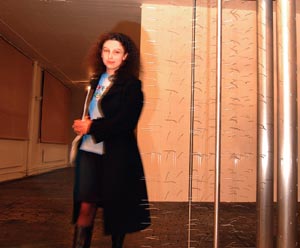by Ken McMullen (dir.), University of the Arts London and The Arts Council. DVD ISBN 072871096X, £14.99.

Where do art and physics meet, and what kind of interaction might they enjoy? In this hour-long film, CERN physicists Michael Doser (anti-hydrogen experimenter) and John March-Russell (theorist) talk to author and artist John Berger (best-known for his 1972 book Ways of Seeing) and Ken McMullen, artist and director of the film.
Their discussion is interspersed with sequences of sculptures, installations and other artworks inspired by particle physics – most from the Signatures of the Invisible exhibition of 2000-2001. I particularly liked Paola Pivi’s Prototype 3 installation of needles on wires performing a kind of synchronized dance and McMullen’s work, Lumen de Lumine, featuring two women (or perhaps one woman, mirrored) whirling balls of light round and round in unison. There are also brief close-ups of famous physics equations being written on a whiteboard, for instance Paul Dirac’s dynamics of spin 1/2 fermions (which led him to predict the existence of antimatter).
The core of the film is the frequently thought-provoking discussion between the scientists and artists. Subjects covered include the symmetry of physics equations versus the arrow of time; what Berger calls “the banal question” of how the huge costs of particle physics can be justified (to which Doser replies that, first, both art and science go beyond the everyday to give meaning to life and, second, pure research can give rise to wholly new types of technology, not just incremental improvements); the contrast between “risky” experiments that hope to gain fundamental insights and “safe” ones that accumulate data; classical versus probabilistic physics (“Where does necessity come into the quantum world?” Berger asks); the search for authenticity in art and for purity in science; and the mesmerizing quality that equations can hold for a physicist, even when they may be used to develop something like the H-bomb.
It is notable that the artists are asking the questions, and the physicists are providing answers. The flow of influence seems to be one way. The profound, often counter-intuitive ideas that science in general, and physics in particular, throw up – quantum theory, antimatter, chaos theory, multiple dimensions – provide non-standard concepts and metaphors to inspire artistic work.
How art might inspire or influence physics is less obvious. In the film, Doser and March-Russell don’t ask Berger or McMullen about their techniques, purposes, or productions. But perhaps the art/science interaction is asymmetric. The general culture that art helps to shape is the pond in which the working physicist swims. And it’s not just pure science that takes time – sometimes more than a century, as Doser points out – to be absorbed into the general culture; the same is true of radically new art.
Interactions of art and physics such as this film can play an important part in making scientific ideas more widely assimilated. Much work and funding go into sometimes rather patronizing efforts to increase the “public understanding of science” – as if bombarding children (and adults) with enough gee-whizzery is bound, sooner or later, to make them interested. This film, like the Signatures of the Invisible exhibition, stands for a more sophisticated and long-term approach, in which science, via art in this case, feeds ideas and inspiration to the broader culture.
• The DVD includes a number of additional items: extracts from the discussion not included in the main feature; a 15 minute film about the manufacture in a CERN workshop of McMullen’s sculpture In Puris Naturalibus; and a reading and discussion of Simon Weil’s poem, “Chance”.








